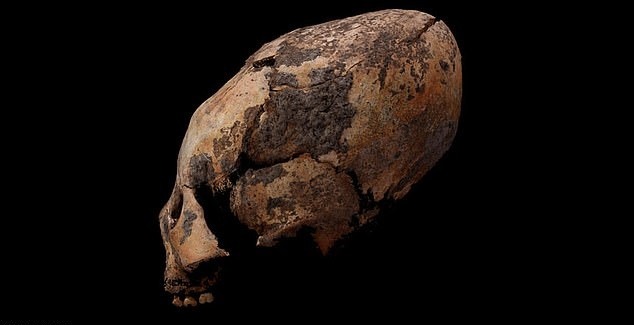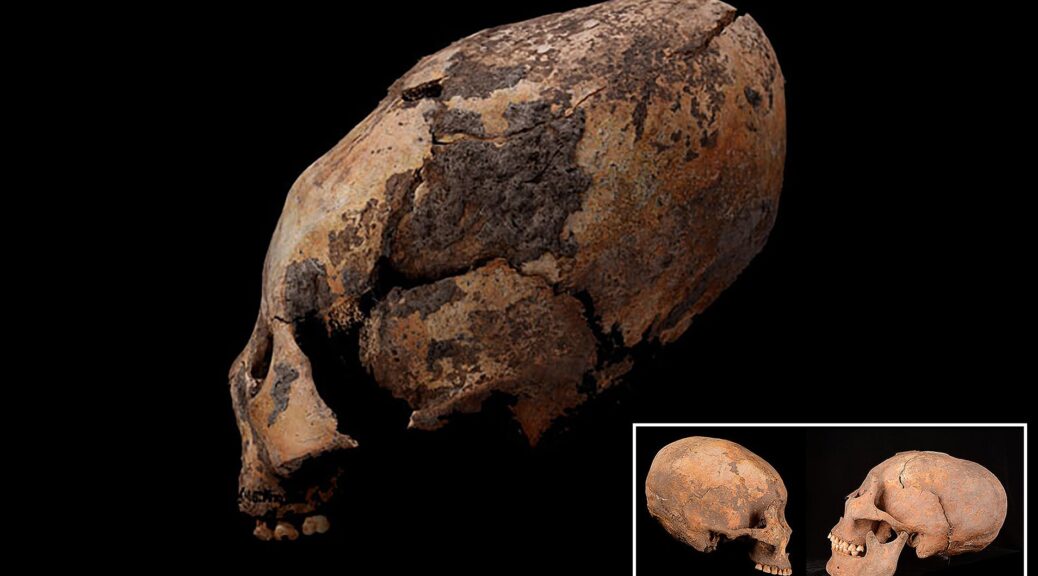12,000 Years Ago, Mysterious Egg-Headed People Inhabited China
Archaeologists excavated 25 human skeletons with elongated skulls dating back perhaps as long as 12,000 years ago from Houtaomuga archaeological site in northeast China.
The strange shape of the skulls symbolizes a part of the ritual in ancient China. The discovery provides additional proof that cranial alterations were prevalent in ancient East Asia and was a customary practice throughout the world during prehistoric times.
According to a study published in the American Journal of Physical Anthropology in 2019, a team of researchers, led by bioarchaeologist Quanchao Zhang and paleoanthropologist Qian Wang, discovered 25 skeletons at a location known as Houtaomuga.
The remains were dated between approximately 12,000 and 5,000 years ago. Out of the 25 skeletons, 11 had skulls that had been intentionally elongated, with flattened bones at both the front and back of the head.
The researchers from China’s Jilin University and Texas A&M University who conducted the excavations were surprised at the abundance of “anomalies” and suggested that many were “egg-shaped.”
Study co-researcher Qian Wang, an associate professor in the Department of Biomedical Sciences at the Texas A&M University College of Dentistry said: “This is the earliest discovery of signs of intentional head modification in Eurasia continent, perhaps in the world.
If this practice began in East Asia, it likely spread westward to the Middle East, Russia, and Europe through the steppes as well as eastward across the Bering land bridge to the Americas.”

The Chinese civilization is one of the most ancient and continuous in the world. While their recorded history can be traced back to the 5th century BC, with the emergence of the Zhou dynasty, there is archaeological evidence that suggests their history dates back even further.
The earliest documented records refer to semi-mythical people called the “Yellow Emperor” and his beastly advisors – known as the “Foolish Old Men.”
Currently, the Chinese egg-shaped skulls are considered to be the oldest in the world. Besides, it was noted that the tradition of stretching heads had been formed long before the Neolithic Revolution (First Agricultural Revolution) took place. It was believed that the tradition of skull modification started around 9,000 years ago.
According to Archaeology, the discovered skulls exhibited artificially elongated braincases and flattened bones at both the front and back of the head.
The researchers identified three different types of cranial deformations in eleven of the skulls. Out of these 11, five were adults, with one female and others male. The remaining skulls belonged to children, and the ages of the individuals varied from 3 to 40 years old.
Scientists still do not know why in ancient times people deliberately pulled their skulls out and where it started. The children’s heads were clamped in a special vice or in a device of two boards. In the process, not only the bones of the skull were stretched, but also the inside structure deformed. At the same time, the bones of the skull became very thin.

Archaeologists believed that humans with deformed skulls were trained to perform important social roles. For example, to become priests of a certain cult.
They believed that elongated skulls would open some unusual abilities, and allow them to communicate with higher powers. At least, people probably thought that by pulling back their heads, they acquire a strong social status in their society.
For centuries, our ancestors utilized various wooden, rag, and rope techniques to scar their own and their children’s heads, seeking aesthetic enhancement. The desire for such body modification has persisted worldwide for thousands of years, with some still practicing it, especially in Africa.
The reason behind this practice remains uncertain, puzzling scientists who can only surmise that some compelling motivation drove our forebears to endure such pain. Even though the Houtaomuga man is the oldest known case of deliberate skull reshaping in history, it is a mystery whether other known instances of deliberate skull reshaping spread from this group, or whether they rose independently of one another, Wang said.

Oddly shaped, intentionally modified skulls have been discovered in various regions across the globe. While assertions from the 1980s contended that two Neandertal skulls, estimated to be around 45,000 years old, had been reshaped during infancy, numerous scholars have since refuted these claims.
The most ancient skulls that exhibit widely acknowledged indications of cranial modification date back to approximately 13,000 to 10,000 years ago in the western areas of Asia, southeastern Australia, and most recently, East Asia. On the other hand, this practice began over 8,000 years ago in the Americas.
Despite the popular belief that the elongated skull, thought to be around 12,000 years old, was intentionally altered, some experts disagree. Although the skull does display some elongation, it is not significant enough to suggest intentional deformation. In fact, evidence only supports forced skull modification in those dating back 6,000 years ago.
The peculiar case of “Paracas skulls” is another discovery of elongated skulls, however, it is different from the rest of skull elongation cases.
The size of the cranium of Paracas skulls is significantly larger, by 25% and 60% heavier than typical human skulls, which indicates that they were not artificially altered through head flattening. Moreover, these skulls possess a single parietal plate, instead of two. Due to the absence of any cranial deformation, the elongation of these skulls remains unexplained and has been so for many years.
The significance of the discovery in Houtaomuga remains noteworthy, irrespective of the ongoing controversy. It highlights the existence of deliberate skull alterations during the Neolithic period in the region. Additionally, the findings offer insights into the community’s culture and convictions during the latter phase of the Stone Age.
